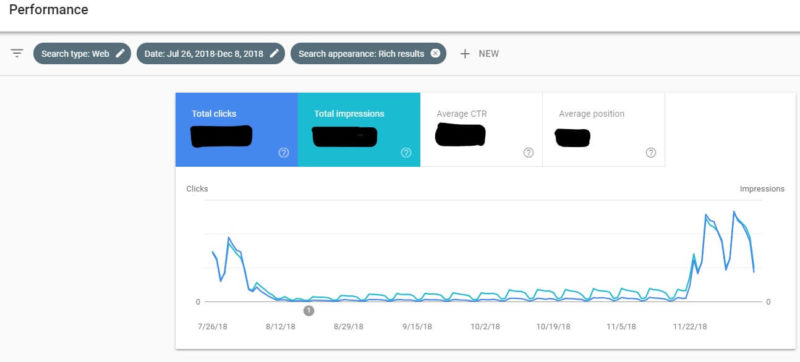On Aug. 1, Google released an algorithmic update (aka “the Medic update”) and since then many websites, especially those in the health niche, are trying to find a way to get their traffic back.
We experienced a staggering blow from this update and it has been a real struggle to overcome it, not to mention a real stress test for our business. We want to share our insights and methodology to help the community.
Our website is in the health niche where someone can find information about physicians, see reviews from verified patients and schedule an appointment for free.
Since 2015, we have been working systematically on our SEO and were proud of our progress. Until one day everything changed.
What just happened?
The Aug. 1 update came hard on us!
This update was about reassuring a safe journey on sensitive topics like health, finance and anything related that could affect users well being.
Websites covering content around these topics have to be extra cautious not to try and manipulate users into purchasing products or services they never really intended to buy.
That is why the name YMYL (Your Money or Your Life) has been given to this kind of websites.
Since we got hit by this update, we assumed we didn’t qualify as a trustworthy source and our main objective was to re-establish our E-A-T (Expertise, Authoritativeness, Trustworthiness) according to Google’s new standards.
The impact this update had on our website
A month after the update, the results were disheartening. We lost on average 50 percent of our organic traffic:
Organic traffic (August vs. July):
- -72 percent drop on our blog (health articles and guest blogging)
- -44 percent drop on our content pages (information about health and medical topics)
- -47 percent drop on out listing pages (physicians and clinics)
- -47 percent drop for our product pages (a physicians private page)
* percentages are counted in sessions; seasonality is included
On average our SERPs dropped by five positions.
How we encountered the drop on our blog and content pages
Our blog is on a subdomain and mostly consists of glossary medical terms and articles by physicians and guest blogs.
We were aware of some SEO problems but we believed it would not affect our main domain.
The drop was so profound that we quickly assumed it was the root of all our problems. So we were forced to treat it as a spam website.
What we did
- We used “nofollow”’ on every link pointing from our website to our blog and vice versa.
- We used a different footer on our blog and completely separated it from our main domain until they became two different entities, with almost no interlinking.
- We went aggressively through the old style boost, nuke or noindex process.
We also had to deal with the structure of our content, both on our blog and our main domain.
Falsely, we had combined the Do intent (to find a physician for a specific medical condition aka the “listing page”) with the Know intent (to learn about a medical condition aka the “knowledge” page) into the same page, sadly honoring the YMYL label that had fallen upon us.
So we completely separated them and kept each page focused on the user intent we wanted to appear for in the search results.
- Know: Pure content with health information about a specific medical condition with as fewer promotional destruction as possible.
- Do: Listing pages especially focused on the particular medical condition
What we also did
- We reduced the amount of our promotional CTAs from four to five to just two or even one.
- We created an editorial policy and openly informed how we verify health information.
- We enhanced our author’s bio information.
- We had physicians review the content and added them as reviewers (inside the schema as well).
- We linked the author profiles with author pages (only with bio information) and also their website (if available).
- We added forms asking doctors and patients feedback.
In other words, we made sure that we not mess with our’s (and Google’s) user intent, made sure our promotional tactics were as minimal as possible and got as much feedback as possible.
How we encountered the drop on our listing and product pages
Since the very beginning, we identified a very serious problem with our rating star snippets in the rich results. They stopped appearing under every physician page in the search results as they used to and 30.000 verified reviews from patients for approximately 5.000 doctors simply disappeared!
Losing our rating stars was certainly interdependent with the major drop we had on both on our product and listing pages and this usually happens during big updates. This was another clear signal we have quality problems and that we need to work towards our E-A-T.
After a lot of research and going through the Google Quality Reviews Guide several times we decided to focus on three key elements to solve this.
1. Check online reputation
This was one of the earliest recommendations and it was a great source of hints that helped us create a personalized E-A-T to-do list.
We were really surprised when we found a couple of reviews online from people saying that our physician ratings are untrustworthy. Could this be it?
Our review policy is pretty straightforward and we do everything by the book, so we didn’t believe this could be true. Obviously, the problem was that we did not share this with our users in a clear and friendly way.
We came up with some great ideas to solve this by adding more information to make our users feel safer. Our recovery happened before we had time to implement any of these changes, so we know for a fact that as far as it concerns just a couple of bad reviews online it’s not an important factor.
But still, it was a great source for information and helped us understand what E-A-T is for our website and where we should focus.
2. Update structured data and metadata
After some digging, we found something that looked like a glitch on the algorithm.
Our website has two languages and while the rating stars didn’t work for our main country-language they were still showing up for search terms in the translated version!
This was so strange, but we successfully replicated the issue with a multi-language website of a competitor in another country, using a proxy.
After clarifying that the star rating snippet was working in only one language, we only had to figure out why, in our case, it had chosen the translated version instead of the main language.
(I even started a topic on Webmaster Forum, you may check it if you are interested.)
So in parallel with our E-A-T, we started working on our structured data in case there was a problem we were missing.
What we did:
- We checked all our structured data again, applied all the recommended schemas and removed as many warnings as possible.
- Instead of only using language targeting hreflangs we also added language-country targeting and the x-default, according to Google’s guidelines.
- In the sitemaps, we listed for index only in the main language
3. Google auto-translate plugin
Back in January, we released the second language for our website. We translated most of our resources but we still had a lot of work ahead of us. So, we used the Google auto-translate plugin, as a temporary solution.
On Oct. 19, we decided to remove the plugin because we had reasons to believe that it might somehow interfere with the crawlers. I think it’s a diabolic coincidence that Marie Haynes tweeted this just a few days after our recovery.
There is a nice discussion going on and John Muller has also joined so you may want to check it out.
We never guessed at the time that it could be something considered as spam and honestly, I don’t know how Google may have crawled these pages. We were careful enough to use the “rel=canonical” and we found no signs of these pages being indexed.
In any case, this was indeed one of our changes.
Results and key takeaways
While many online SEO tools may have been triggered on the 26th, I am 100 percent sure the “Thanksgiving update” happened on the 22nd because we witnessed the recovery happening in real-time.
Not only did we get our traffic and SERPs back, but now the performance is even better, taking into consideration the seasonality.
We could only speculate, as a community, if this is a rollback update of some kind or a reward update for the hard workers.
But from our point of view and after a couple of weeks, our changes worked and we certainly got a boost we had never experienced before.
Blog and health content pages
Our decision to focus on user search intent and accordingly separate our pages was a total success!
We got our SERP back for our “knowledge” content pages and as a “reward,” we also rank for the same search term with the targeted listing pages for many search terms, even on the top three positions in some occasions.
Organic traffic of listing pages (targeted to a specific medical treatment):
The surge happened earlier on Oct. 7.
Organic traffic of content pages (targeted to a specific medical condition):
Listing and product pages
We got our rating stars back and along with them all of our traffic and SERPs.
We knew that if we managed to get our rating stars back everything would return to normal (and it did) so we never stopped working around the “algorithm glitch” theory.
Our last change before the update was a drastic one. We decided to completely remove the rating schema from the English pages in hopes it would trigger the crawler to prefer our main language for the rating stars. And two days later our rating reviews came back!
Until we find out more about the update, we find it hard not to believe that the rating schema triggered everything. The true paradox is that now we can’t replicate the problem on our competitors as we used to. Coincidence or not, this update had something to do with it.
Next steps
Even though we recovered, we will keep working in the same direction. For one, these are strange times and we have been witnessing many rollercoaster behaviors. Secondly, this experience helped us understand the true meaning of E-A-T even though we still need to do a lot more work to be confident.
In sharing our case study, we are not suggesting that these changes will work for everyone but we found a magic formula for recovery for our site.
The key takeaway is that every change we implemented made our website stronger, safer and the user experience better. This is what you should focus on.
Opinions expressed in this article are those of the guest author and not necessarily Search Engine Land. Staff authors are listed here.









